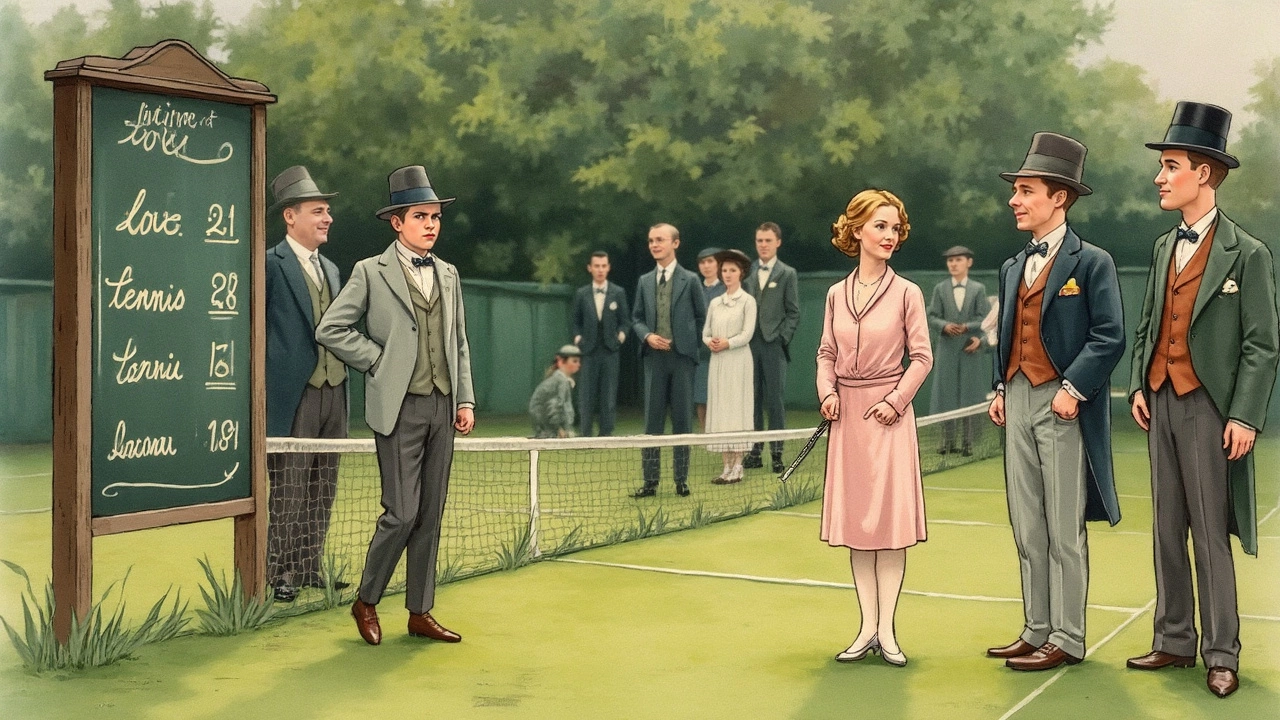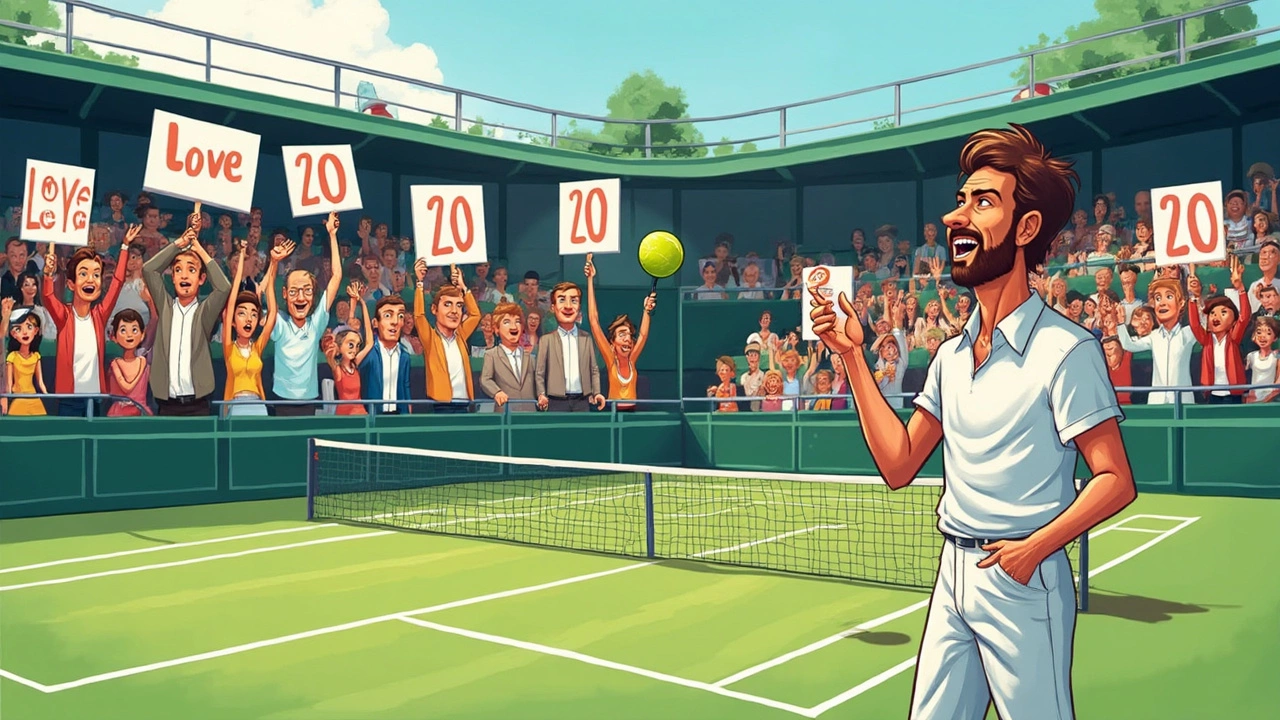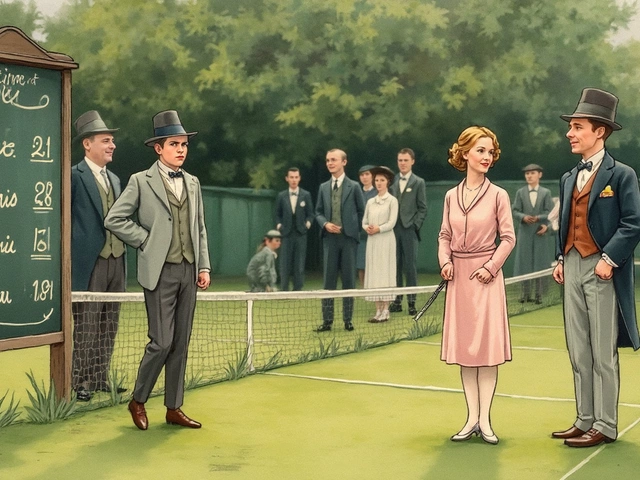Why Is 0 Called Love in Tennis? Unpacking the Story Behind the Score

The first time you listen to a tennis match, you’ll probably notice something strange: when a player doesn’t have any points, the scorekeeper says ‘love’. It’s not 'zero'. Not 'nil'. Just 'love'. Most people don’t stop to think about why, but if you’re the curious type, you’re in the right place. Understanding where the term comes from and how it fits into tennis scoring can actually help you follow matches more easily, especially when the score announcements start sounding like code.
If you’ve ever found tennis scoring confusing—don’t worry, you’re not alone. The sport seems to have a secret language. Getting familiar with terms like ‘love’ lets you keep up with the game and might even help you look smarter in front of your friends the next time there’s a Grand Slam on TV.
- The Oddity of 'Love' for Zero
- Where Did the Term 'Love' Come From?
- Popular Theories and Debunked Myths
- How Scorekeeping Works in Tennis
- Tips for Explaining Tennis Scoring
- Fun Facts About Tennis Lingo
The Oddity of 'Love' for Zero
So here’s the thing: in what other sport do you hear the word ‘love’ thrown around during score announcements? Pretty much nowhere but tennis. Even if you’re new to the game, it jumps out right away. When the score is 40–0, it gets called ‘forty-love.’ The word might sound positive, but it means the player has nothing—zip, nada, zero.
You’d think tennis would just say ‘zero’ like soccer uses ‘nil’ or how we usually say ‘zero’ in everyday life. But tennis went with its own path and stuck with something that confuses a lot of people at first. If you listen to a tournament on TV or even a local rec match, you’ll hear ‘love’ dozens of times an hour. ESPN once estimated that in a typical men’s Grand Slam match, the score ‘love’ pops up more than 100 times.
The language of scoring is one of the game’s biggest quirks. And funny enough, this odd bit of tennis lingo has stuck for hundreds of years. It’s become so normal to fans that if someone said ‘zero’ aloud, it would actually sound weird. The scoring style is even baked into tennis video games and training apps that try to keep things as official as possible.
| Sport | Word for Zero |
|---|---|
| tennis | Love |
| Soccer | Nil |
| Baseball | Zero |
| Basketball | Zero |
| Cricket | Duck |
So, if you’ve ever wondered why this weird word shows up on the scoreboard, you’re in good company. It’s one of those things that makes following tennis both fun and just a little bit tricky at first. Once you get used to it, you might even start saying ‘love’ instead of zero when you’re joking around with friends or teaching someone new how to keep score.
Where Did the Term 'Love' Come From?
If you hear ‘love’ in tennis, it means zero, not romance. But why? People have argued about its real origin for decades. The most accepted theory is that it comes from the French word “l’oeuf,” which means “egg.” Why an egg? Well, an egg looks like a zero, so French players may have said “l’oeuf” instead of zero to describe a scoreless player. English speakers, maybe not the best with French pronunciation, heard it as 'love' and kept using it. The timeline below highlights the main theories and facts:
| Year/Period | Event |
|---|---|
| Late 1800s | Tennis becomes popular in England, and the game’s French roots stick around, including terms like “l’oeuf.” |
| Early 1900s | English-speaking players favor 'love' because it's quick and easy to say. |
| 1960s–present | Historians squabble over the true origin, but the "l’oeuf" story stays strong. |
There’s another theory, but it has less evidence: some claim ‘love’ stands for playing with nothing on the line but love of the game. But historians have mostly agreed it’s the French egg theory that makes the most sense.
Here’s something you can use to clear things up when someone asks, “What’s up with ‘love’ in tennis?”:
- It replaced zero because “l’oeuf” (egg) sounded like “love”.
- It stuck because people needed a simple, quick way to announce a score of zero.
- The idea that 'love' means playing for fun isn’t backed up by real history.
One thing’s for sure: the tennis world isn’t changing this anytime soon. You can thank some muddy French-to-English translations and a funny-looking egg for one of the quirkiest words in sports.
Popular Theories and Debunked Myths
A lot of old stories try to explain why tennis scoring uses the word ‘love’ for zero. Some sound logical, while others are just plain strange. If you’ve ever wondered what’s true and what’s not, here’s a look at the most common theories about why ‘love’ means zero in tennis.
- The French word 'l'œuf': The most popular theory is that ‘love’ comes from the French word ‘l’œuf,’ which means ‘the egg.’ An egg is shaped like a zero, so it makes sense. French influence on early tennis is huge, so this theory gets repeated a lot.
- English mispronunciation: Some say English speakers heard ‘l’œuf’ (pronounced kind of like "luff") and turned it into ‘love.’ Since the two words sound similar, this story stuck around for ages.
- Playing for love of the game: Another idea is more romantic. It claims that when a player had zero points, they were still ‘in the game for love,’ meaning they weren’t winning anything except the fun of playing. As nice as it sounds, historians can’t prove this ever factored into tennis scoring.
But let’s separate fact from myth. There’s no hard proof that ‘love’ was a direct translation from ‘l’œuf.’ Linguists have pointed out that old English sports used ‘love’ to mean a scoreless situation even before tennis was big in England. A few early English card games and cricket used ‘love’ for zero way back in the 1700s.
The following table breaks down theory popularity and evidence:
| Theory | How Many Historians Support? | Any Real Proof? |
|---|---|---|
| French 'l'œuf' = egg = zero | High | No concrete historical document |
| 'Love of the game' | Low | Just old stories, no records |
| Early English sports lingo | Medium | Mentioned in old English sport books |
So, while a lot of people think tennis scoring owes its ‘love’ to an egg, the real answer may lie in British slang and early games. The ‘l’œuf’ idea is catchy, but the evidence to back it is pretty thin. Either way, if someone asks you about it, you’ve now got more than just a tall tale to share.

How Scorekeeping Works in Tennis
It’s easy to get tripped up by tennis scoring if you’re new to the game. Instead of just counting up 1, 2, 3, and so on, tennis does things its own way. The points go: 0 (called love), 15, 30, 40, and then game. That’s right—no 45. And that 40 is really just one point away from winning the game, but it’s not exactly logical math. Most of this comes from old traditions, but it’s stuck around because it keeps things unique (and, let’s face it, a little mysterious).
Here’s how a typical game works once you start playing:
- Each player starts with zero points, which gets called ‘love’ by the umpire.
- First point is 15, second is 30, third is 40.
- Win a point after 40 and you take the game—unless both players get to 40, which turns into ‘deuce’ (basically a tie).
- From deuce, you have to win two points in a row—first to get ‘advantage’, then win again to take the game.
Check out how the point system looks in a standard game:
| Points Won | Score Called |
|---|---|
| 0 | Love |
| 1 | 15 |
| 2 | 30 |
| 3 | 40 |
| 4 | Game (if not tied at deuce) |
Matches break down into sets and then into games. Players need to win six games (by two) to take a set, and most regular matches are best-of-three sets. Weird as it sounds, these traditions keep tennis interesting. The key is just listening for ‘love’ at the start of the game or when someone hasn’t scored yet—and from there, let the numbers (and tradition) guide you.
Tips for Explaining Tennis Scoring
Breaking down tennis scoring for friends or newcomers can feel tricky at first, but once you know the basics, it’s like teaching someone the rules to a board game—just takes a few clear steps. Here’s what helps most when someone gives you that confused look after hearing “forty-love.”
- Start Simple: Explain that a regular game goes up in points: 0, 15, 30, and 40, then game. If both players reach 40, it’s called “deuce.” After deuce, a player needs to win two points in a row to take the game.
- Mention ‘Love’: Point out that 'love' simply means zero. So, if the score is “love-15,” the first player has zero and the other has one point.
- Score Format: The server’s score is always said first. So, if you hear “30-15,” the server has 30, the opponent has 15. The announcers never flip it.
- Games, Sets, Matches: Spell out that players need to win six games (by two) to win a set, and most matches are the best of three or five sets, depending if it’s men’s or women’s singles at a major tournament.
- Keep It Visual: Drawing a simple chart or score line helps people keep track. If you’re watching at home, jot down scores as they go up for extra clarity.
Lots of people get foggy around the numbers, especially since nobody says “1, 2, 3, 4” in tennis. Even if you mess up once or twice, that’s totally normal—many longtime fans still have to pause and focus whenever a match hits deuce after a long rally.
| Description | Score Called |
|---|---|
| No points | Love |
| 1st point | 15 |
| 2nd point | 30 |
| 3rd point | 40 |
| Tied at 40 | Deuce |
| One point after Deuce | Advantage |
| Win next point after Advantage | Game |
One reminder—when you’re showing someone the ropes, don’t skimp on the weirdness factor. People love hearing why tennis says “love” instead of “zero,” and it’s a good hook to get them invested in following matches and scorecards. It’s a lot, but once it clicks, tennis scoring makes any match 10x more fun to watch.
Fun Facts About Tennis Lingo
If you hang around tennis fans, you’ll hear way more than just 'love.' Tennis has a whole dictionary of unique words. Here are some facts that’ll give you a new appreciation for the sport’s language.
- The word ‘deuce’ pops up when both players hit 40 points. Weirdly, it’s not even an English word—it comes from the French phrase 'à deux le jeu,' which means 'the game with two players left to win.' It just stuck around.
- If someone says the score is 'forty-love,' that’s 40 points to zero. Remember, 'love' is just fancy tennis for 'nada.'
- Ever heard ‘bagel’? Players and fans use 'bagel' when someone loses a set 6-0. Picture the zero in '6-0'—it looks like a bagel.
- A 'break point' means the receiving player has a chance to win the game from the opponent’s serve. Feels like a mini drama every time.
- ‘Ace’ isn’t just the top card in poker. In tennis, an ‘ace’ is when you serve so well, your opponent doesn’t even touch the ball.
Here’s a little data table that shows some of the most used tennis lingo and what it means during a match:
| Term | What It Means |
|---|---|
| Love | Zero points |
| Deuce | Score is tied at 40-40 |
| Advantage | One player needs one more point to win the game after deuce |
| Break Point | Opportuniy to win a game on your opponent’s serve |
| Ace | A serve that isn’t touched by the receiver |
| Bagel | Losing a set 6-0 |
You’ll also hear terms like 'let' (that’s when a serve hits the net but still lands in) and 'rally' (players hitting the ball back and forth until someone wins the point). If you’re just starting, don’t stress—most people pick this stuff up after a few matches (my dog Max even wags his tail for an ace now, true story).


